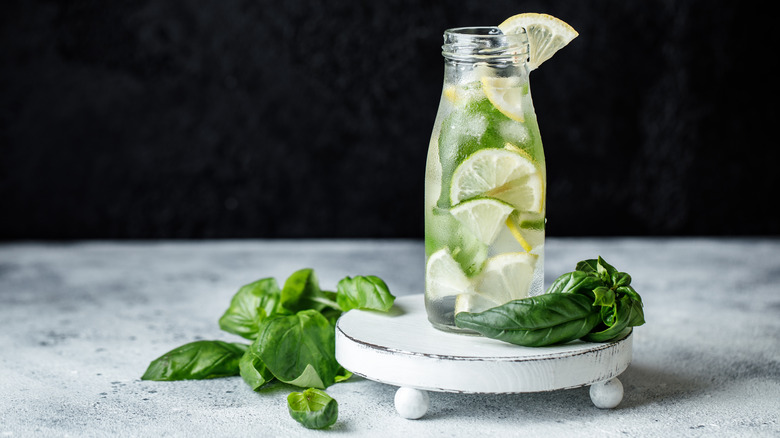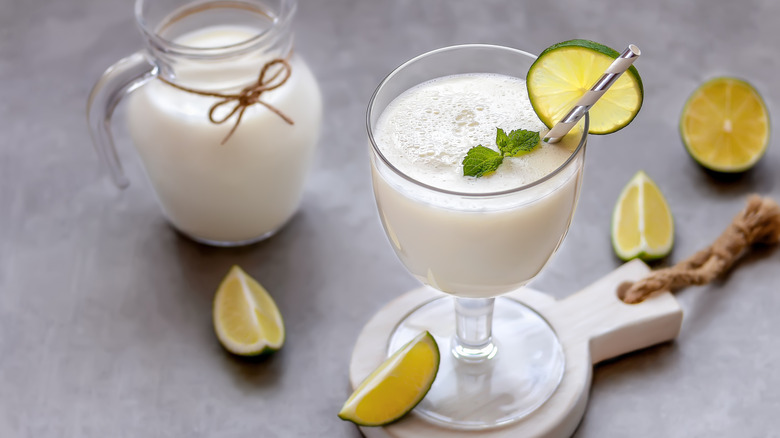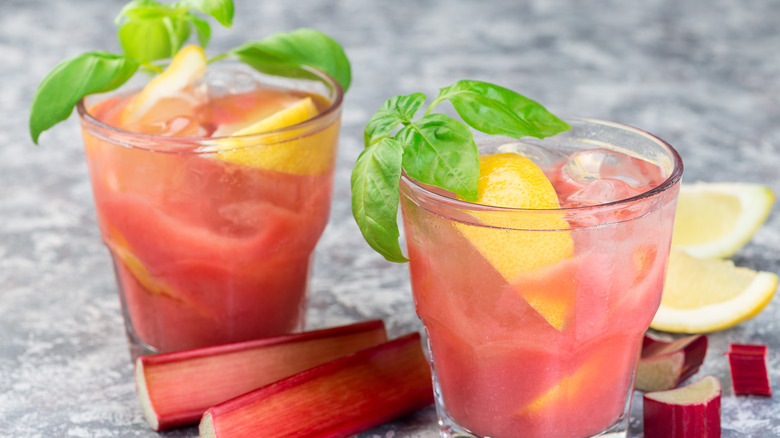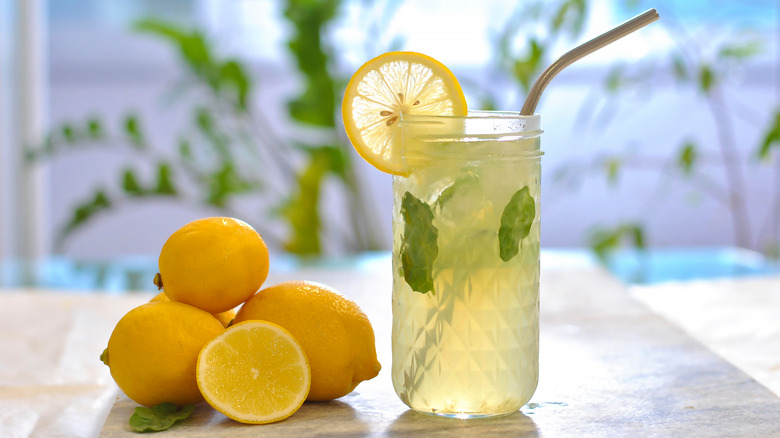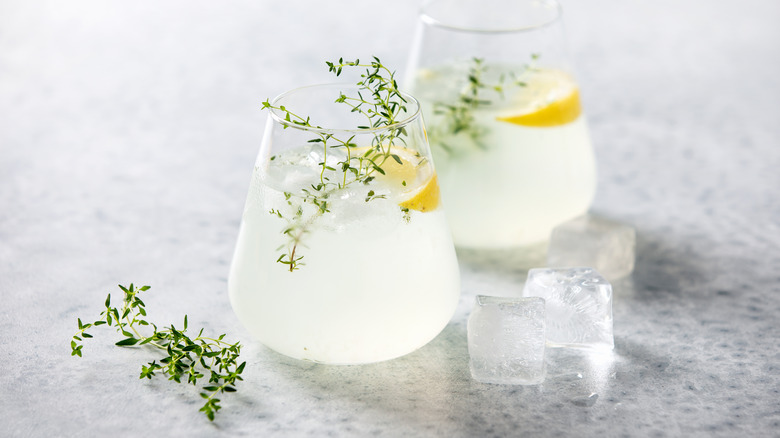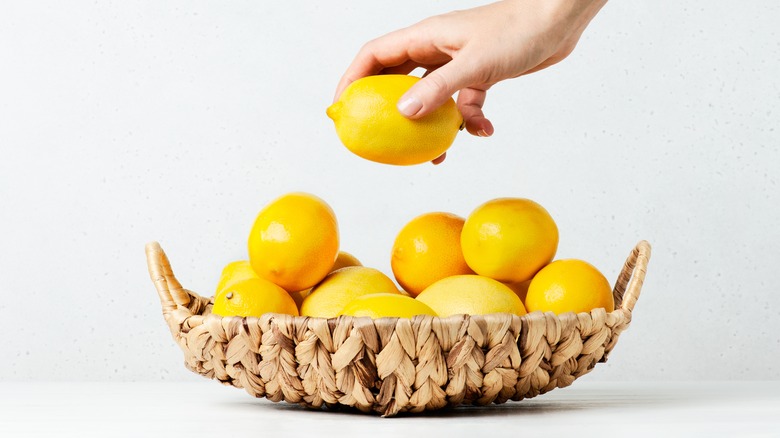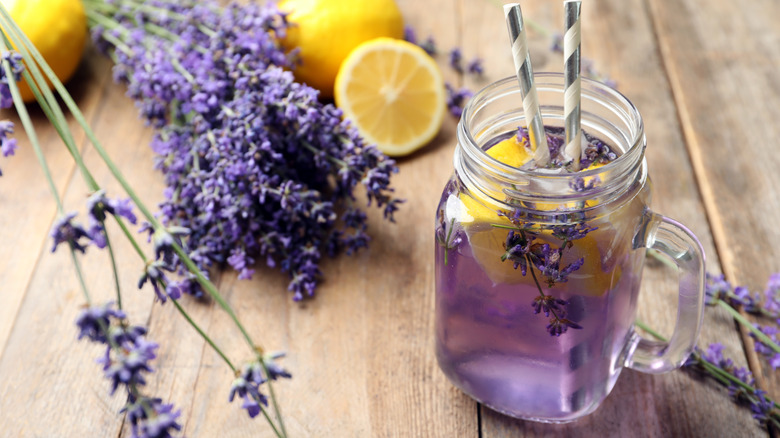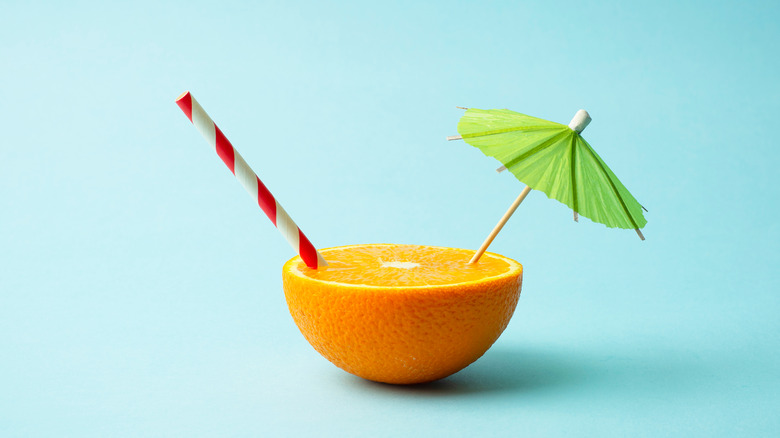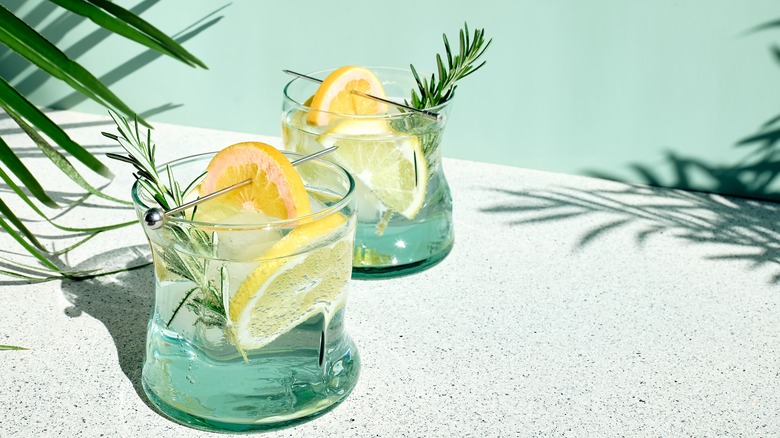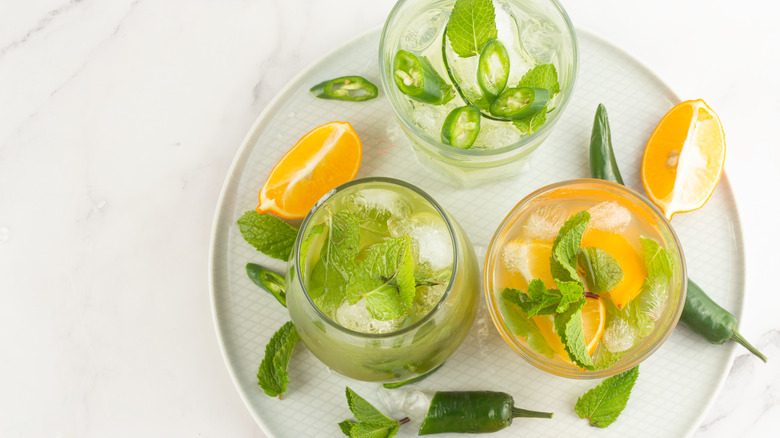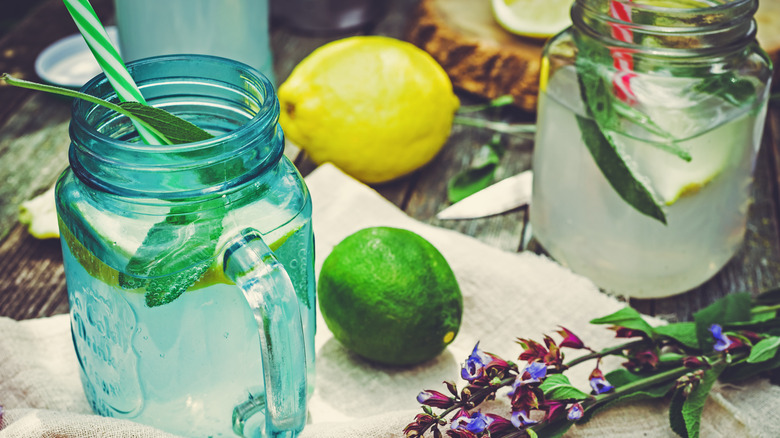14 Things You Should Be Adding To Your Lemonade, But Aren't
There's nothing like a cold glass of lemonade on a hot summer day. Its tart sweetness cools and refreshes whether you sip it at a picnic, refresh yourself after yard work, or feel like relaxing and watching the world go by. Real Simple notes how easy it is to make lemonade concentrate to store in the refrigerator or even the freezer. This method allows for customization by the glass or pitcher, whether you prefer syrupy sweet lemonade or more of a pucker.
People enjoyed lemonade in ancient Egypt over 1,000 years ago, and by the 17th century, Parisians made lemonade a trend. European immigrants to America brought lemonade with them in the 18th century, and temperance advocates tried to make lemonade a chic alternative to alcohol. At the same time, lemonade add-ins like strawberries or iced tea are traditional, many ways to elevate lemonade.
Lemon zest brightens the flavor of lemonade with essential oils that can be missed if you squeeze the lemon and toss the rind. It's easy to use a citrus zester or a microplane to add those flavorful oils into your lemonade, but feel free to use a vegetable peeler. Peel the zesty yellow layer from the lemon, mince it finely and taste the magic. To bring the perfect summertime drink to next-level deliciousness, read on.
1. Basil
Although we often associate basil with savory dishes like pesto, pasta sauce, and Caprese salads, its light herbal flavor goes beautifully with the sweetness of lemonade. Celebrity chef Andrew Zimmern loves to blend fresh lemonade with ice cubes, basil, and mint to serve with spicy dishes, noting that having simple syrup on hand makes whipping up lemonade at a moment's notice a snap.
Adding basil to lemonade is only the beginning — you can build a tapestry of flavors with a bit of imagination. If sweet lemonade is your jam, try blending up strawberries, peaches, or mangoes with basil for a fruity herbal lemonade that will revitalize you on the stickiest summer afternoon. Serious Eats notes that using honey instead of sugar adds dimension to basil lemonade, and including a pinch of salt will enhance the flavors.
Are you looking to add some veggies to your day? Instagram users are all about adding cucumbers and basil to lemonade, with some recipes using flavored seltzer for fizz and observing that a shot of alcohol for the adults would be tasty. Basil is easy to grow and may be dried or frozen so that you can enjoy basil lemonade at any time of year.
2. Condensed milk
Frozen lemonade is easy to find at restaurants, food trucks, street vendors, and ice cream stores, but if you're looking for lemonade that crosses into dessert territory, add condensed milk and maybe some whipped cream on top. One taste, and you'll have a new summer favorite.
Tik Tok, a social media favorite for cool recipes and food hacks, made lemonade whipped with condensed milk and ice a trend, and honestly, it's incredibly easy to make and tastes sublime. Our recipe uses heavy cream in addition to condensed milk, plus a quick garnish of whipped cream, but feel free to play around with how much you use if you're counting calories. Our Mashed recipe developer, Susan Olayinka, notes that substituting coconut milk for condensed milk would work as a dairy-free alternative. It sounds like whipped lemonade is in everyone's near future.
Brazilian lemonade also uses condensed milk but is served over ice rather than blended with ice-like whipped lemonade. Serious Eats notes that although Brazilian lemonade is mainly made using limes, substituting lemons would also be tasty. Try it both ways and see which is more refreshing on those hot summer days.
3. Melon
One of the best parts of summer is the seasonal fruits, including sweet, juicy melons. Blending melon into lemonade puts a new twist on two favorite summer flavors and brings extra health benefits at the same time. Wondering which melon goes with lemonade? You'll be happy to know that any melon, including watermelon, cantaloupe, and honeydew, are all great choices. Use any melon you have on hand and try blending it with lemon, simple syrup, and ice if you like it slushy.
Tasting Table recommends adding lemon zest to your simple syrup, then blending with fresh lemon juice and cubed watermelon for an extra kick of lemony flavor. Many recipes for melon-y lemonade favor straining the mixture to keep it clear. This is a fine idea, especially if you don't want to pick out seeds before blending the melon. However, if you want all the health benefits of melon in your drink, feel free to leave your lemonade pulpy. Hint: If you blend it with ice to make a slush, the texture will be fine and can easily serve as a snack or dessert.
Wendy's has jumped on the melon lemonade bandwagon if you don't have time to make it yourself, although making it yourself is the freshest option. Undecided about cantaloupe? Cantaloupe and honeydew are interchangeable in their nutrient profiles and can be swapped in any recipe. If you prefer the taste of honeydew, your melon lemonade will be just as healthy and tasty.
4. Something bubbly
Sparkling lemonade isn't a new idea; Parisians have enjoyed it since the 17th century. Bubbly lemonade is a cocktail staple. For example, a Kentucky lemonade is a mixture of lemonade, bourbon, and ginger ale. Any sparkling lemonade cocktail can be a springboard for ideas, but booze aside, adding a sparkly element to lemonade adds a bit of fun and is customizable to your taste and what you have on hand.
Adding sparkling water or club soda to your lemonade lowers the calorie count while enjoying a sweet-tart glass of lemonade. There are seemingly endless numbers of flavored sparkling waters that can elevate your lemonade. Try a lemon or lime sparkling water, or opt to complement the lemon flavor with something else, like berry-flavored water.
If your jam tends more toward sweet-bubbly, try any lemon-lime soda along with your favorite lemonade recipe. If you enjoy ginger ale, omit the bourbon from Kentucky lemonade, whip up a simple syrup infused with fresh ginger, and add it to sparkling water. If you're fighting a summer cold, ginger and honey work well together and can be an immune booster. Adding something bubbly to lemonade will always be a crowd pleaser, whatever you're in the mood for.
5. Rhubarb
Rhubarb gets a bad rap sometimes. Some people swear by strawberry rhubarb pie, some love to crunch on it raw, and some refuse to eat it. Whatever camp you fall into, rhubarb's tart flavor goes nicely with lemonade, and will turn it a gorgeous shade of pink to boot. Rhubarb's taste is often declared citrusy, so it seems natural to pair it with lemon and sugar.
Fans of strawberry rhubarb pie can use the pie filling to blend with lemonade, and if frozen lemonade appeals, adding ice to the blender instantly gives you a slushy treat. If you want to be super fancy, Tasting Table notes that rhubarb syrup accented with lime zest, cardamom, peppercorns, and celery seed is delicious paired with soda water; we think it would elevate lemonade to gourmet goodness.
Always choose firm, red rhubarb stalks that are no more than two inches wide for the best flavor for any recipe (per Better Homes and Gardens). If the stalks seem tough or there are obvious imperfections, you can trim the stalks with a vegetable peeler or a knife. Remember, the leaves are mildly toxic and should be discarded safely so children and pets can't find them. Rhubarb is a healthy addition to lemonade, boosting the drink with vitamin K1, vitamin C, and a punch of antioxidants. When the dog days of summer settle in, whip up some cold rhubarb lemonade and relax in the shade with this healthy concoction.
6. Mint
Mint is a versatile plant that humans have been using medicinally and in the kitchen since 1500 BC. Today, we use mint leaves in tea, chopped up in salads like tabbouleh, muddled in cocktails like mint juleps, and served with lamb dishes. Mint flavoring is ubiquitous in candies, ice cream, breath mints, and toothpaste, and there are many varieties you can grow not only for cooking but for decorative garden beds.
In Israel, mint lemonade is far easier to find than the plain old lemon variety. Tasting Table reports that Israelis call it limonana and find it most refreshing in their scorching summer season. It's made by simmering mint leaves and lemon zest in sugar syrup, then straining it and combining it with lemon juice. It's sometimes served over ice, but many prefer blending it with ice cubes to make a slushy treat to cool off on the hottest days.
Mint and melon is a classic cocktail combination (via The Spruce Eats), and since we already learned melon pairs beautifully with lemonade, why not try a triple threat? Tasting Table uses a similar sugar syrup to the Israeli limonana, simmering mint and lemon zest along with sugar and water till thickened, then blending it with watermelon and lemon juice to make fresh lemonade perfect for summer sipping. If you have another variety of melon on hand, try it with mint. We bet you'll love it.
7. Thyme
Everyone loves a sweet glass of lemonade, but savory herbs paired with lemon heighten the flavor and take plain lemonade to the next level. If you're wrinkling your nose at the thought of thyme lemonade, you should know that fresh thyme is different from the dried leaves sold in jars. It has a gentler flavor, reminiscent of fresh mint, and if you need more convincing, there's even a variety of thyme with citrusy notes, unsurprisingly called lemon thyme. Lemon thyme is a perfect match for lemonade, but any variety of thyme will brighten up your drink.
Taste of Home notes that a delicious way to make thyme lemonade is to grill the lemons and the thyme first. They explain that dipping the lemons in sugar before grilling them gives them a complex, caramelized flavor, and that soaking the thyme in water before it's grilled keeps it from charring. After grilling, the thyme needs to steep in simple syrup before making the lemonade. These extra steps are worth the effort!
Adding other fruit to thyme lemonade not only kicks up the flavor, but also boosts your drink's nutritional profile. Thyme goes particularly well with peaches, honeydew, and cherries, which will all make for a luscious lemonade combination. Consider simmering thyme sprigs in simple syrup before blending with lemon juice and the fruit of choice. Pour over ice to serve, or add ice to the blender if you'd like a slushy treat.
8. Whole lemons (not just the juice!)
If you enjoy complex flavors, using whole lemons in lemonade might be right up your alley. Lemonade is generally sweet — sure, lemon juice is sour, but with a good amount of sugar, the general vibe is a sweet drink with a pucker at the end. The entire lemon, minus seeds (and some of the pith if the lemons have thick skin), creates a bitter edge to play off the sweetness, which is delightful in hot, sticky weather. Plus, lemon zest brings a bright essence that can't be beat.
Simply Recipes explains some tips for using whole lemons in lemonade. Certainly, washing the lemons is essential, especially if they aren't organic. The rounder and squishier lemons are, the juicer they will be with less bitter pith. If you have lemons with particularly thick skin, trim some of the white pith away. After quartering your lemons, trim them as you like and remove as many seeds as you can, tossing the rest into the blender. Add cold water and sugar to taste, and blend. For frozen lemonade, blend with ice.
Some like to strain the pulp, but if you have a high-powered blender and like some texture, there's no reason you can't leave it in. Lemons have many health benefits, including reducing the risk of heart disease, preventing kidney stones, and boosting your immune system. So next time you want a frosty lemonade, do your health and taste buds a favor and use whole lemons.
9. Lavender
Lavender, the beautiful purple perennial that attracts bees and butterflies, has myriad uses. A staple of herbal medicine, it is believed to help promote sleep, reduce headaches, and even relieve menstrual pain (via Cleveland Clinic). Its scent graces soaps, lotions, candles, and cleaning products, and you may have used culinary lavender without even realizing it, since many brands that produce the spice blend Herbes de Provence use lavender.
If you grow English or French lavender in your garden, try making a lavender-infused simple syrup for lemonade. The Cleveland Clinic likes to make a kind of tea by simmering two tablespoons of dried lavender in four cups of water, then adding a little honey before straining the lavender and adding lemon juice. The Mayo Clinic suggests making a compote by simmering two cups of water, a package of frozen blueberries, ¼ cup of sugar, and a tablespoon of lavender. The mixture is then strained and mixed with lemon juice and Splenda and served over ice.
As always, you can customize the amount or type of sweetener in your drink, blend it with ice for a slushy lemonade, or opt to leave any fruit pulp in to boost the nutritional value of your lemonade. Removing the lavender sprigs after infusing is recommended for textural reasons, and if you don't grow lavender at home, look for culinary lavender wherever you buy spices.
10. Oranges
Orange juice is a staple in most kitchens, and it's a natural addition to lemonade. While you could certainly use orange juice right from the carton, whole fruits are better for you. Oranges are packed with vitamin C, folate, fiber, antioxidants, calcium, potassium, and citric acid, which can inhibit the formation of kidney stones (via WebMD).
As long as you wash oranges well, blending the entire fruit (minus seeds) into lemonade adds the health benefits already mentioned and may also rev up your metabolism and help you feel full, thanks to all that fiber. Use any oranges you like and have on hand for orange lemonade. You can get fancy and use Cara Cara or blood oranges for a boost of extra nutrients — and to get a gorgeous red-tinted lemonade. If you have Valencia oranges for juicing, those are fine, too, or use clementines, navel oranges, or tangerines.
Whichever oranges you choose to add, we think Taste of Home's idea to make simple syrup and adding orange and lemon zest and juice to steep for at least an hour is a good one. This fruity syrup is added to cold water and poured over ice before serving, so it can be made by the glass or for a crowd. Follow your heart — whether you prefer to strain the zest, blend whole fruits, or turn it into a frozen dessert with ice, orange lemonade will be a new favorite.
11. Rosemary
Rosemary is a fragrant herb with a flavor all its own, sometimes described as piney. It's used in many dishes but is also known as an insect repellent and for its ability to improve concentration and decrease stress. Its citrusy, herbal notes pair beautifully with lemonade, and whole sprigs make a lovely garnish. Cooling off with fresh rosemary lemonade during the afternoon slump on a summer workday might improve your productivity, or at least your mood.
The best way to make rosemary lemonade is to put two or three rosemary stems into a simple syrup, either allowing it to simmer or letting it steep for an hour or two before removing them. Although fresh sprigs of rosemary are less potent than dried rosemary, you should aim to complement the flavor of the lemons rather than overpowering it. Adding ginger ale to rosemary lemonade makes an elegant sparkling drink perfect for any occasion.
In a Reddit thread on r/cocktails, users suggested fruit and rosemary combos, including pears, strawberries, pomegranates, grapefruits, and apples. Experimenting with adding fruit to rosemary lemonade sounds like a win to us!
12. Chili peppers
We love a cold glass of lemonade when the weather is scorching, but you might feel even more refreshed if you add chili peppers. There's a reason that cuisines from hot climates tend to feature spicy foods – they can help your body cool down by sweating, the physiological way humans cool off.
On the Reddit thread r/easyrecipes, users have shared recipes for spicy lemonade using various types of peppers and basil seeds, also known as sabja seeds. Sabja seeds have been a staple ingredient in India and southeast Asia and are full of soluble fiber, minerals, and plant compounds (via Healthline). Mango chili lemonade would be a delightful thirst quencher for a more complex flavor profile.
Think about how much spice you like before you race to add chili peppers to simple syrup, which recipes recommend for herbs. Try adding a couple of chili slices to each glass, or steeping chilis for up to half an hour in the simple syrup and removing them. Everyone's tolerance for heat is different, but remember: You can always add heat, but you can't remove it. The easiest way to remove the seeds from chili peppers is using a spoon; once you've mastered the trick, chili pepper lemonade will be a summer favorite.
13. Sage
Sage is a savory herb often associated with turkey stuffing at Thanksgiving. Still, since it belongs to the mint family and has a lemony undertone, it's a yummy match with lemonade. Rich in vitamin K, vitamin B, iron, and antioxidants, it's also a healthy addition to your drink (via Healthline). Adding mint leaves and sage will enhance the minty undercurrent in the sage itself and add a fresh flavor. Classic mint varieties pair nicely, but varieties like banana, grapefruit, and apple mint would also add a zesty touch.
Sage lemonade made a splash on Instagram, and it sounds perfect. One user points out that pineapple sage smells fruity rather than earthy and says that simmering and steeping the leaves in simple syrup and muddling leaves in each glass makes out-of-this-world lemonade when combined with pineapple sparkling water.
Blogger Morgan Eisenberg shared a recipe for boozy blackberry sage lemonade. She makes her simple syrup with blackberries and sage, which she simmers till thick and then strains. She adds lemon juice, water, and vodka, and garnishes with blackberries, slices of lemon, and sage leaves. Whether you like it boozy or omit the vodka, this drink sounds like a winner.
14. Limes
Lemons and limes are citrus fruits and can be substituted in certain recipes, but limes are less acidic and have more vitamin A, vitamin C, calcium, and folate than lemons. Together, they taste like summer, making limes an excellent add-on to lemonade. Plus, garnishing with green and yellow slices of fruit adds a certain charm.
If you want a fabulous drink/dessert combination, Tasting Table has a winner from pastry chef Chris Hanmer that tops frozen lemon slush with juicy sugared strawberries, and tops the glass with fresh limeade. You might need a straw and a spoon to eat it, but nobody will complain! The lemon slush does take time to freeze, so for instant gratification, floating sliced strawberries in lemon-limeade works, too.
Many fruits pair beautifully with lime, Instagram users agree. Cran-lime lemonade is pretty, and you can mix your favorite cranberry juice blend with fresh lemon-limeade. Watermelon lemon-limeade blends watermelon chunks into lemon and lime syrups for a bright pink drink that will cool you on the hottest day. Your preference for textures and sweetness should dictate the exact recipe; strain the watermelon pulp for a more transparent drink, leave it like a smoothie, or add ice and blend it to slush. Whichever way you like it, lemon limeade will delight you all summer.

